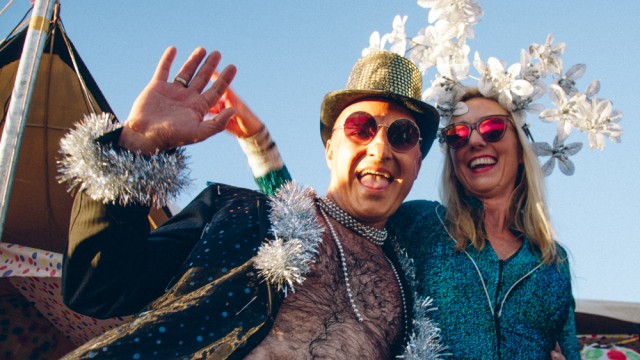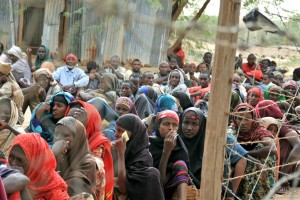No other continent is burdened with as many cliches and misconceptions as Africa. Despite increased travel to the continent and easy access to information via the internet, age-old stereotypes and myths about Africa persist, leaving many with the impression that the entire continent is barbaric, hot, poor, dangerous, and diseased.
Even the image above, which presents a set of rather benign symbols associated with the continent, nevertheless reinforces certain stereotypes.
Before you travel to Africa, it helps to unload your preconceptions. Let Africa surprise you; being open-minded to the true nature and diversity of this fascinating continent will help you engage more fully with the places you go and people you meet.
So in order to de-bunk the most common myths, here is a list of things Africa is, and isn’t:
Africa is all about wildlife: Yes, there is wildlife in Africa, which is perhaps the continent’s biggest draw. Millions come every year to go on safari and get up close and personal with elephants, giraffes and lions, which are, for the most part, confined to huge game parks and wildlife conservation areas. But tourists who fly in, head directly to a game park, then fly out bypass all the other things that define Africa: sophisticated modern cities, colorful traditional villages, diverse religions, joyful music, historical shrines, majestic mountains, and teeming rivers. To pigeonhole Africa as “that continent with exotic animals” ignores the complexity and diversity of a continent that has 54 countries, hundreds of micro-climates, thousands of ethnic groups, and is the size of the U.S., China, India, Japan, and Europe combined.
All of Africa is hot: A few years back, a bunch of rock stars made a charity record to raise money for African famine relief. The lyrics said “There won’t be snow in Africa this Christmas.” Wrong! Almost anywhere there’s a mountain range in Africa, it snows. It snows in the Atlas mountains of Morocco, where there are ski resorts. It snows on Mount Kilimanjaro, so if you plan to climb it, please dress accordingly! It snows in the Rwenzori mountains of Uganda, the Semien mountains of Ethiopia, and the Drakensburg mountains of South Africa. Snow was even sighted recently on Table Mountain, in the coastal city of Cape Town. Aside from snow, there’s a lot of climactic diversity on the continent. West African countries near the equator do tend to be dry and warm year-round, but the rest of the continent is a mixed bag of hot, cold, dry, humid, wet, windy or still, depending on the season, the altitude and the latitude.
Africa is violent and dangerous: Frightening news reports about civil wars and insurgencies, coupled with statistics on carjackings, murder and rape in various parts of Africa feed the perception that the continent is dangerous and hostile to travelers. But news reports can misrepresent a city or country’s true nature. If travelers only relied on newspapers and murder statistics to decide where it was safe to go, no one would ever visit New York City, Chicago or Los Angeles. What you won’t see on the news is the everyday reality of Africa’s friendliness and safety. Most of the continent is very safe and attacks on tourists are rare, with the exception of some countries and certain neighborhoods. Of course you don’t want to go to Cairo during an uprising, to certain parts of Lagos after dark, or to Somalia or Sierra Leone at ANY time. But once you know the local danger zones, don’t be afraid to get out and explore the rest of your destination.
Africa is awash with disease: There is a lot of illness and disease in Africa, but it’s not because the continent has a higher per-capita amount of germs. It’s more a function of lack of access to things like vaccinations, basic health care, and health education. It’s very easy to avoid a dread disease by simply getting vaccinated and/or taking preventative measures. Yellow fever, typhoid, hepatitis and meningitis can be prevented with a jab, while anti-malarial pills plus insect repellent and proper clothing will protect you against malaria and dengue fever. As for HIV/AIDS, yes, it is more prevalent in Africa than almost anywhere else, but it’s transmitted the same way as anywhere else in the world; if you don’t practice risky behavior, you won’t get it.
Most Africans have AIDS: Like I mentioned above, HIV and AIDS are a substantial problem in Africa, though infection rates vary widely from country to country and region to region. It’s highest in southern Africa, where countries like Swaziland and Botswana have a 25% infection rate, and Zimbabwe, Namibia, Mozambique and Zambia hover around 15%. Infection is lowest in North Africa: Egypt and Morocco have rates of just .1%. The center of the continent is somewhere in between: places like Kenya, Gabon, Congo (DRC) and Cameroon fluctuate between 4% and 6%. Eradication has proved difficult, mostly due to stubborn cultural attitudes and stigmas that surround the disease. Wherever you may go in Africa, your chances of getting HIV/AIDS as a traveler are slim to none, if you follow the usual precautions.
Africans are all starving and/or refugees: As mentioned earlier, Western charity fundraisers, along with media images of emaciated children in refugee camps, have unwittingly perpetuated the idea that all Africans are on the brink of starvation, dislocated, and constantly in need of external aid in order to get by. While it’s true that famine does break out occasionally in isolated areas, and wars turn people into refugees, this is by no means a continent-wide phenomenon.
Africans are uncivilized and barbaric: Back in the 19th century, European invaders considered Africans to be “savages” because they weren’t Christians, didn’t wear a lot of clothing, and had customs that seemed strange and sometimes cruel. Although we now recognize that civilization comes in both Western and non-Western varieties, the “uncivilized” reputation persists. Some point to the civil wars, corrupt public officials, and murderous dictators as evidence that Africa is still a “dark continent.” Others take issue with the poverty, disease, and bad roads. Well, none of these things indicate a lack of civilization. They may indicate a lack of economic and political development, but not much else.
Most Africans are dirt-poor: While there are many millions of poor Africans living in slums, there are a huge number of rich and middle-class ones living in suburbs. Some countries, like South Africa, are quite rich overall, while others countries are poor on average but have pockets of wealth and privilege, particularly around large cities. Bear in mind that the income gap between rich and poor is much wider in Africa than in other regions, which magnifies the differences. It’s also worth noting that many Africans of modest means tend to live in different conditions than those in the West, which may make them appear poorer than they are. A rural farmer in Tanzania who lives in a dirt-floored cottage and wears worn-out shoes is not necessarily a pauper; he is probably just an average guy living in the style of his ancestors.
All Africans are black: The great majority of sub-Saharan Africans are in fact black, but sizable non-black minorities exist. For example South Africa has several million white people of European descent, as well as Cape Malay people of mixed Indonesian-Indian heritage. Whites are also common in Zimbabwe, Namibia, Kenya, and Tanzania. Over 1.5 million Indians and people of Indian descent live throughout east Africa, in Kenya, Tanzania and Uganda. In North Africa, the majority of people are olive-skinned and have more in common linguistically and culturally with the Middle East than with sub-Saharan Africa.
Africans wear loincloths, have bare breasts, and carry spears: At one time in the distant past, sub-Saharan Africa was primarily tribal, and many people did wear simple (or very little) clothing and carry weapons. But that Africa is mostly gone and Western influences have penetrated all corners of the continent. Yes, some San bushmen and Masai tribesmen still dress in the style of their ancestors, but many Africans dress Western-style, drive cars and carry cell phones. (Even some Masai have cell phones, by the way.)



